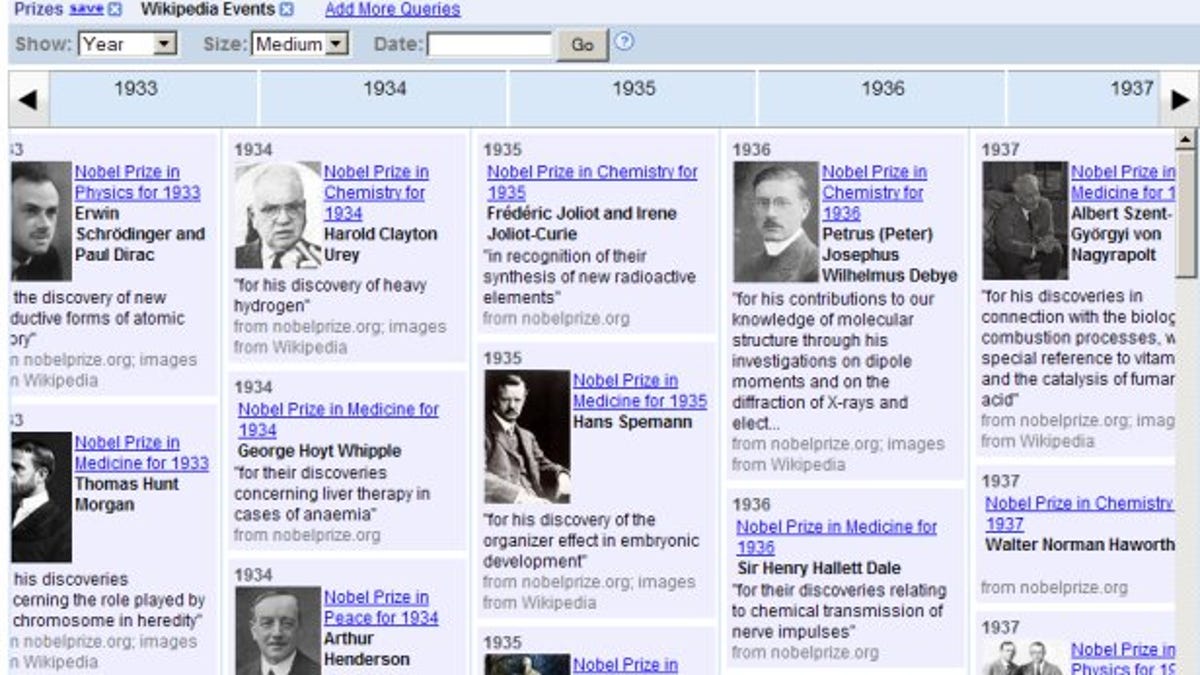Google spotlights news timeline, labs work
Innovation is alive and well at the search giant, Google took pains to point out Monday by showing off a timeline and other new Google Labs work.

SAN FRANCISCO--Google, perhaps eager to counter any worries that its engine of innovation is sputtering after the down economy triggered the closure of various projects, shed light on two new projects and on a revamped Google Labs site for bringing others to the public's attention.
One of the two projects, News Timeline, lets people browse history through Google's eyes, with a sliding chronological framework that draws information from newspapers, Wikipedia, and other sources. The other, Similar Images lets people search for images that look like one they've already found.
Overall, Google wants more people to try its experiments, to "engage the user as soon as possible and get the products calibrated for success," in the words of R.J. Pittman, director of product management for Google's consumer-oriented technology.
Google generally would rather gather feedback quickly and adjust course accordingly than present the world with what it deems to be a completed product, even if that risks having to withdraw products or features that flop or misfire, he said.
"Launch early and launch often," Pittman said. "There's a growing backlog of interesting things coming from Google."
The new labs site, built on Google App Engine, unifies various other labs work, including Gmail Labs, and lets people rate and comment on projects.
"We're trying to create awareness so people know when we're trying out new stuff," Pittman said. "For us to be realistic about the products, to get adaptive, we have to have a fast iteration rate."
Timeline
The News Timeline project is the baby of Andy Hertzfeld, one of the original designers of the Apple Macintosh software and something of a Silicon Valley icon. He said he's grown interested in zooming user interfaces, and with the timeline, you can click a time category to zoom from year to month to week to day, and double-click to back out as far as a decade-level view.
"You can see how your subject evolves over time," Hertzfeld said, adding that the history goes back as far as the 1400s.
The interface requires people to select what type of information they're seeking--newspapers, music, movies, prizes, blogs, and more. Some content comes from Wikipedia or the Freebase project to organize information on the Web that's structured with descriptive data such as dates; other content is licensed from organizations such as The Associated Press for news photos, Time magazine for its covers, or various newspapers that partnered with Google to bring their archives online.
Having to select a category in which to search runs contrary to Google's modus operandi, which generally relies on search term context to infer what type of information a person is seeking. Hertzfeld said Google tried that approach, with searches modified by keywords, but found problems in the project's currently early stages.
For now at least, Google has no plans to make money off the timeline project, Hertzfeld said. "Literally we haven't thought about it at all. First we want to get a user base who loves it," he said.
Image search
Image processing is a difficult subject for computers good at distinguishing a one from a zero but not a house from a tree. The ease with which humans perform such tasks has generally eluded computers.
Image-processing software from Google and others therefore have relied inordinately on "meta data"--accompanying text such as captions and titles. Google is working on a more sophisticated understanding though, for example through face recognition in Picasa Web Albums.
On Monday, the company showed off a technology that, for a subset of images it's found on the Web, can identify similar photos. The technology works by "computing the visual distance" between two images then finding the nearest neighbors in the image database, said Radhika Malpani, the Google director of engineering who presides over image search work.
The technology can be convenient for searching for images rapidly that fit a visual idea that may be hard to express--the Louvre with its pyramid dominating the foreground, Brad Pitt and Angelina Jolie with Pitt on the left, for example.
I found it had some use for identification tasks--what variety of cactus is that?--though a better database doubtless would help. Google is expanding the number of photos that have been categorized with the technology.

